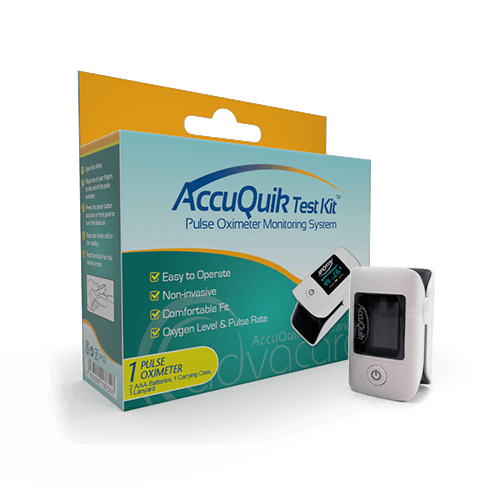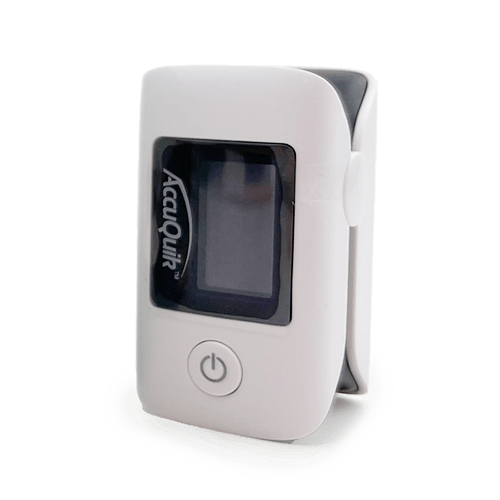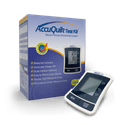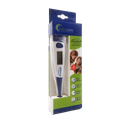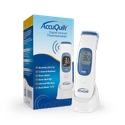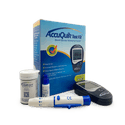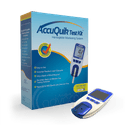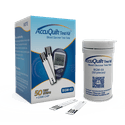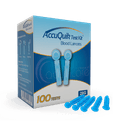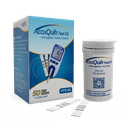- Home›
- Medical Devices›
- Diagnostic Detection Devices›
- Portable Medical Devices›
- Fingertip Pulse Oximeter
Fingertip Pulse Oximeter
Features
Packaging
What is a Fingertip Pulse Oximeter?
A Fingertip Pulse Oximeter is a medical diagnostic tool used to measure heart rate and the oxygen saturation level in the blood. The device is portable and non-invasive and works quickly. It is commonly utilized in medical environments and also by individuals, such as pilots, athletes, and individuals at home.
AdvaCare Pharma is the exporter and manufacturer of Fingertip Pulse Oximeters. These devices are produced in facilities situated strategically worldwide, which allows for better control of the supply chain. Our ISO and CE-certified manufacturing sites undergo regular inspections to ensure strict adherence to international standards.
Product Specifications
Features
The Fingertip Pulse Oximeter is equipped with a large OLED display that offers 5 display modes and 10 levels of adjustable brightness, which allows for clear and convenient readings. It features an auto power-off function to conserve battery life. It has a built-in beep function for signal indication. It is powered by two AAA batteries, adding to its portability and ease of use.
The fingertip pulse oximeter measures oxygen saturation levels (SpO2) with a display range of 0% to 100%, and a measurement range of 70% to 100% with a resolution of 1%. The accuracy of the SpO2 measurement is within ±2%. Additionally, the fingertip pulse oximeter is able to measure pulse rate from 30 beats per minute (bpm) to 240 bpm.
Why are we a leading Fingertip Pulse Oximeter manufacturer?
AdvaCare Pharma is an American-owned pharmaceutical company that specializes in manufacturing Fingertip Pulse Oximeters and other reliable diagnostic medical devices that are part of our AccuQuik™ range. Our company utilizes a unique supplier-distributor relationship that differentiates us from other large-scale medical manufacturers.
Over the past 20 years, AdvaCare Pharma has cultivated a strong reputation as a leading pharmaceutical distributor across 65 regions. Our well-established worldwide network includes distributors, hospitals, pharmacies, and many other institutions.
Uses
What is a Fingertip Pulse Oximeter used for?
A Fingertip Pulse Oximeter is an indispensable medical device utilized for assessing physiological parameters, primarily oxygen saturation levels (SpO2) and pulse rate. These metrics supply insights into an individual's cardiopulmonary health status, aiding in the diagnosis, monitoring, and management of various medical conditions.
How is a Fingertip Pulse Oximeter used?
Utilizing a Fingertip Pulse Oximeter involves a straightforward yet important process in healthcare monitoring and diagnosis. The individual places their fingertip, usually the index finger, into the device's sensor, where specialized photodetectors emit two wavelengths of light—usually red and infrared—through the skin.
These wavelengths penetrate the skin and interact with oxygenated and deoxygenated hemoglobin molecules in the blood, allowing the device to quantitatively determine the oxygen saturation level and pulse rate. The oximeter swiftly analyzes the light absorption patterns and computes the SpO2 and pulse rate readings, which are promptly displayed on the device's screen.
This non-invasive and painless procedure aids in continuous monitoring of patients, including those with respiratory diseases, cardiovascular conditions, or undergoing anesthesia. The compact and portable design of fingertip pulse oximeters enables individuals to monitor their oxygen levels conveniently during physical activities, travel, or high-altitude adventures.
How should a Fingertip Pulse Oximeter be stored when not in use?
Adequate storage of a Fingertip Pulse Oximeter is paramount to preserving its accuracy, reliability, and longevity for sustained use. After each use, the device should be meticulously cleaned and sanitized using a soft, dry cloth to remove any residue, oils, or contaminants accumulated during the measurement process.
It should be securely placed in its designated carrying case or pouch to shield it from environmental factors such as dust, moisture, or mechanical damage. Storing the oximeter in a dry and cool environment, away from direct sunlight and extreme temperatures, helps mitigate the risk of premature deterioration or malfunction.
Regular inspection of the device and its accessories guarantees that they remain in ideal condition for accurate readings and uninterrupted performance.
How does a Fingertip Pulse Oximeter work?
A Fingertip Pulse Oximeter operates on the principle of spectrophotometry, utilizing specialized sensors to measure the absorption of light by hemoglobin molecules in the blood. The device emits two wavelengths of light—red and infrared—through the skin, where it penetrates the underlying capillary beds.
Oxygenated hemoglobin absorbs more infrared light, while deoxygenated hemoglobin absorbs more red light. Detecting the intensity of light transmitted through the tissue, the oximeter can then calculate the ratio of oxygenated to deoxygenated hemoglobin, thereby determining the oxygen saturation level (SpO2).
Simultaneously, the device detects pulsatile changes in blood volume, enabling it to derive the pulse rate based on the periodic variations in light absorption associated with each heartbeat.
These physiological parameters are then displayed in real-time on the oximeter's screen, providing healthcare professionals and individuals with valuable insights into cardiopulmonary function.
What does a Fingertip Pulse Oximeter measure?
A Fingertip Pulse Oximeter measures two primary physiological parameters: oxygen saturation (SpO2) and pulse rate. Oxygen saturation refers to the percentage of hemoglobin molecules in arterial blood that are bound to oxygen molecules, indicating the efficiency of oxygen transport from the lungs to peripheral tissues.
Pulse rate, on the other hand, represents the number of heartbeats per minute and presents information about cardiac rhythm and overall cardiovascular performance.
Can a Fingertip Pulse Oximeter be used at home?
Yes, a Fingertip Pulse Oximeter is suitable for use in home healthcare settings as a convenient and accessible means of monitoring their oxygen saturation levels and pulse rate.
Many individuals, particularly those with chronic respiratory conditions such as chronic obstructive pulmonary disease (COPD), asthma, or sleep apnea, benefit from regular oximetry monitoring to assess their respiratory status and establish timely intervention in case of oxygen desaturation episodes.
Individuals recovering from illnesses or undergoing postoperative care at home can use fingertip pulse oximeters to monitor their progress and detect any signs of respiratory compromise or cardiac abnormalities.
Athletes, fitness enthusiasts, and individuals engaging in high-altitude activities can utilize oximeters to assess their physiological responses to exercise or environmental stressors, enhancing performance and safety.
Can a Fingertip Pulse Oximeter be used during physical activity or exercise?
Yes, a Fingertip Pulse Oximeter can be used during physical activity or exercise to monitor oxygen saturation levels and pulse rate in real-time.
Athletes, fitness enthusiasts, and individuals undergoing rehabilitation programs can benefit from continuous oximetry monitoring during exertion to assess their cardiopulmonary responses to exercise intensity and duration.
Through tracking SpO2 levels and pulse rate during physical activity, individuals can maximize their training regimens, identify signs of overexertion or oxygen desaturation, and adjust their exercise intensity accordingly to prevent adverse events such as hypoxemia or cardiac arrhythmias.
Fingertip pulse oximeters give valuable feedback on cardiovascular fitness and endurance, helping individuals gauge their exercise tolerance and progress towards fitness goals.
What are the benefits of using a Fingertip Pulse Oximeter for remote patient monitoring?
Fingertip Pulse Oximeters present several advantages for remote patient monitoring, particularly in the context of telemedicine and home-based healthcare services:
- They empower patients to monitor their own oxygen saturation levels and pulse rates from the comfort of their homes.
- These devices enable early detection of respiratory or cardiac abnormalities, enabling timely intervention and preventing exacerbations of chronic conditions.
- Remote monitoring with fingertip pulse oximeters also strengthens patient engagement and self-management, as individuals gain insight into their health status and learn to recognize warning signs of deterioration.
- Healthcare staff can remotely review oximetry data collected over time, allowing for proactive adjustments to treatment plans, medication dosages, or lifestyle recommendations based on objective physiological measurements.
- Remote pulse oximetry monitoring advances continuity of care and reduces the need for frequent clinic visits, especially for patients with mobility limitations or those residing in rural or underserved areas.
FAQs
How does a Fingertip Pulse Oximeter work?
It works by emitting light through the skin and then measuring the amount of light absorbed by oxygenated and deoxygenated blood. The device calculates the oxygen saturation level in the blood and displays it on the screen.
What does a Fingertip Pulse Oximeter measure?
The device can measure two parameters: oxygen saturation (SpO2) and pulse rate.
Can a Fingertip Pulse Oximeter be used at home?
This oximeter is suitable for use in healthcare settings and at home. It is a portable and non-invasive device that is easy to use for individuals with respiratory or cardiac conditions.
Can a Fingertip Pulse Oximeter be used during physical activity or exercise?
Yes, the oximeter may be worn during exercise. This can be useful for athletes or individuals with medical conditions which require monitoring during physical activity.
Are your Fingertip Pulse Oximeters equipped with user-friendly interfaces?
Yes, our fingertip pulse oximeter comes with user-friendly interfaces meticulously designed to simplify operation and minimize the learning curve for users.
Can your Fingertip Pulse Oximeters be used at home or is it more suitable for clinical use?
Our fingertip pulse oximeters are often sold in pharmacies and other retail channels, and used to check and monitor oxygen levels at home. However, these are also suitable for distribution to hospitals and clinics and other healthcare facilities, where they can be used to provide high-quality patient care. Contact our International Sales Department for more information about the distribution of our oximeters in your market.
Can I distribute your Fingertip Pulse Oximeters online?
Yes, authorized distributors can market our fingertip pulse oximeters via their online platforms, including websites and e-commerce channels. It is crucial to adhere to local regulations and our distribution guidelines for authentic and lawful product distribution.
References
Benefits and Use of Fingertip Pulse Oximeter
This study explores the advantages and applications of fingertip pulse oximeters, focusing on their role in monitoring oxygen saturation levels and providing feedback on the effectiveness of breathing interventions. It highlights the benefits of pulse oximetry in assessing physical activity safety, evaluating oxygen therapy, and detecting potential health issues related to oxygen levels. The study emphasizes the importance of pulse oximeters in various healthcare settings, including monitoring patients with respiratory and cardiovascular conditions.
Pulse Oximetry - PMC - NCBI
This study compared the performance of 20 pulse oximeters under conditions of poor perfusion. Different probes used with a pulse oximeter can affect the accuracy of SpO2 measurements. In patients with poor peripheral perfusion, finger probes had lower precision and more readings within 3% of the reference (CO-oximeter) than other probes. Overall rankings were significantly better for the finger probes than probes on other sites (e.g., ear, nose, forehead).

You might be interested in...
Why AdvaCare Pharma?
As an industry leader, we are aware of our responsibility to provide affordable and sustainable solutions to improve healthcare worldwide.
